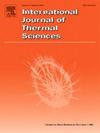Performance investigation of a heatsink with L-shaped fins on a concentric hollow cylindrical tube attached to a round disk
IF 4.9
2区 工程技术
Q1 ENGINEERING, MECHANICAL
International Journal of Thermal Sciences
Pub Date : 2025-02-25
DOI:10.1016/j.ijthermalsci.2025.109818
引用次数: 0
Abstract
This study proposed a heatsink design with efficient heat dissipation to ensure optimal operation and longevity of LED lightbulbs. Assuming the typical form of LED lightbulbs, the heatsink was designed with a base consisting of a concentric hollow cylindrical tube attached to the center of a round disk, and multiple L-shaped fins were installed on this structure. To enhance thermal performance of the heatsink with L-shaped fins, simulations were conducted by varying the deletion fin area and the number of fins. It was confirmed that modifying both the deletion fin area and the number of fins within a certain range was advantageous for improving the thermal performance of the designed heatsink. The simulation methods used for investigating the thermal performance were validated through experiments. Variations in thermal performance were examined based on the Rayleigh number, the number of fins, and the installation angle of the heatsink with L-shaped fins. For the same size and shape of the base, that is, a base consisting of a concentric hollow cylindrical tube attached to the center of a round disk, the heatsink with L-shaped fins was compared to heatsinks with rectangular fins, triangular fins, or perforated staggered fins. The results showed that the heatsink with L-shaped fins exhibited generally lower thermal resistance over installation angles ranging from 0° to 180°. Therefore, the L-shaped fin heatsink proposed in this study is expected to significantly contribute to improving the heat dissipation performance of LED lightbulbs.
本研究提出了一种高效散热的散热片设计,以确保 LED 灯泡的最佳工作状态和使用寿命。根据 LED 灯泡的典型形状,散热片的底座由一根同心空心圆柱管组成,连接到圆盘的中心,并在此结构上安装了多个 L 形鳍片。为了提高带有 L 形鳍片的散热器的散热性能,我们通过改变删除鳍片面积和鳍片数量进行了模拟。结果表明,在一定范围内改变删减鳍片面积和鳍片数量有利于提高所设计散热器的热性能。用于研究散热性能的模拟方法通过实验得到了验证。根据雷利数、鳍片数量和 L 形鳍片散热器的安装角度,研究了散热性能的变化。在底座尺寸和形状相同的情况下,即底座由连接到圆盘中心的同心空心圆柱管组成时,带 L 形鳍片的散热器与带矩形鳍片、三角形鳍片或穿孔交错鳍片的散热器进行了比较。结果表明,在 0° 至 180° 的安装角度范围内,带 L 形翅片的散热片的热阻普遍较低。因此,本研究提出的 L 形鳍片散热片有望显著改善 LED 灯泡的散热性能。
本文章由计算机程序翻译,如有差异,请以英文原文为准。
求助全文
约1分钟内获得全文
求助全文
来源期刊

International Journal of Thermal Sciences
工程技术-工程:机械
CiteScore
8.10
自引率
11.10%
发文量
531
审稿时长
55 days
期刊介绍:
The International Journal of Thermal Sciences is a journal devoted to the publication of fundamental studies on the physics of transfer processes in general, with an emphasis on thermal aspects and also applied research on various processes, energy systems and the environment. Articles are published in English and French, and are subject to peer review.
The fundamental subjects considered within the scope of the journal are:
* Heat and relevant mass transfer at all scales (nano, micro and macro) and in all types of material (heterogeneous, composites, biological,...) and fluid flow
* Forced, natural or mixed convection in reactive or non-reactive media
* Single or multi–phase fluid flow with or without phase change
* Near–and far–field radiative heat transfer
* Combined modes of heat transfer in complex systems (for example, plasmas, biological, geological,...)
* Multiscale modelling
The applied research topics include:
* Heat exchangers, heat pipes, cooling processes
* Transport phenomena taking place in industrial processes (chemical, food and agricultural, metallurgical, space and aeronautical, automobile industries)
* Nano–and micro–technology for energy, space, biosystems and devices
* Heat transport analysis in advanced systems
* Impact of energy–related processes on environment, and emerging energy systems
The study of thermophysical properties of materials and fluids, thermal measurement techniques, inverse methods, and the developments of experimental methods are within the scope of the International Journal of Thermal Sciences which also covers the modelling, and numerical methods applied to thermal transfer.
 求助内容:
求助内容: 应助结果提醒方式:
应助结果提醒方式:


